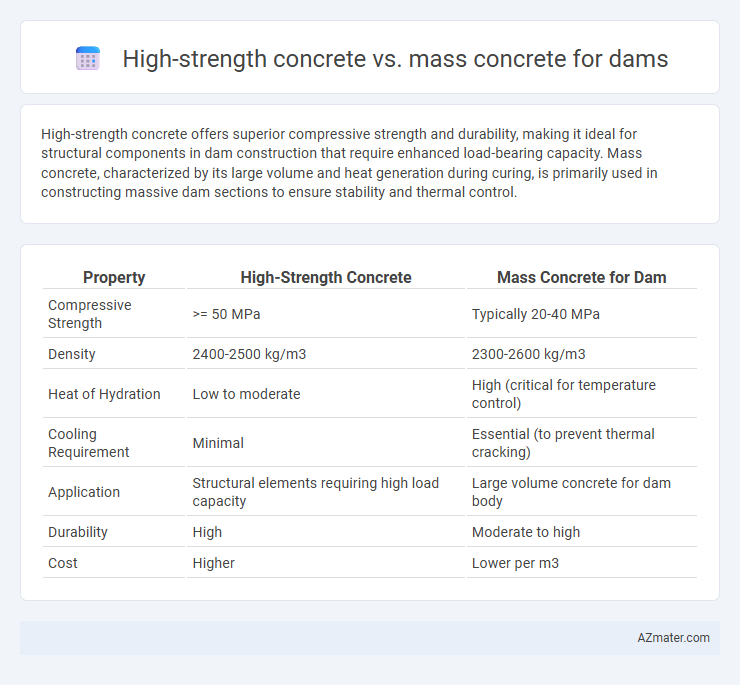High-strength concrete offers superior compressive strength and durability, making it ideal for structural components in dam construction that require enhanced load-bearing capacity. Mass concrete, characterized by its large volume and heat generation during curing, is primarily used in constructing massive dam sections to ensure stability and thermal control.
Table of Comparison
| Property | High-Strength Concrete | Mass Concrete for Dam |
|---|---|---|
| Compressive Strength | >= 50 MPa | Typically 20-40 MPa |
| Density | 2400-2500 kg/m3 | 2300-2600 kg/m3 |
| Heat of Hydration | Low to moderate | High (critical for temperature control) |
| Cooling Requirement | Minimal | Essential (to prevent thermal cracking) |
| Application | Structural elements requiring high load capacity | Large volume concrete for dam body |
| Durability | High | Moderate to high |
| Cost | Higher | Lower per m3 |
Introduction to Dam Construction Materials
High-strength concrete offers superior compressive strength and durability, making it ideal for critical structural elements in dam construction, such as spillways and outlet works. Mass concrete, characterized by its large volume and low heat generation during curing, is essential for constructing massive dam bodies to prevent thermal cracking. Selecting the appropriate concrete type depends on balancing mechanical performance with thermal management to ensure long-term stability and safety of the dam.
Defining High-Strength Concrete
High-strength concrete for dams is defined by its compressive strength typically exceeding 50 MPa, offering enhanced durability and reduced permeability compared to traditional mass concrete. This concrete type incorporates optimized mix designs with supplementary cementitious materials like silica fume and fly ash to achieve higher density and mechanical properties. Its application in dam construction improves load-bearing capacity and minimizes cracking risks associated with thermal stresses during curing, making it essential for complex or high-stress dam structures.
Understanding Mass Concrete
Mass concrete is characterized by its large volume and the resulting heat of hydration, which requires careful temperature control to prevent cracking in dam construction. Unlike high-strength concrete, mass concrete emphasizes thermal management and durability over compressive strength, ensuring structural integrity in bulk applications. Proper mix design, cooling methods, and monitoring are critical to managing internal stresses and maintaining stability in mass concrete dams.
Key Properties: Strength, Durability, and Permeability
High-strength concrete exhibits superior compressive strength exceeding 70 MPa, enhancing the structural integrity of dam components compared to mass concrete, which typically ranges between 20-40 MPa. Durability in high-strength concrete is significantly improved due to its low water-cement ratio and dense microstructure, reducing susceptibility to cracking and chemical attack, whereas mass concrete requires careful thermal control to manage hydration heat and minimize thermal cracking. Permeability in high-strength concrete is substantially lower, limiting water ingress and enhancing long-term performance, while mass concrete's higher porosity necessitates protective measures to prevent seepage and degradation.
Thermal Behavior and Temperature Control
High-strength concrete exhibits lower thermal conductivity and reduced heat generation from hydration compared to mass concrete, enhancing temperature control during dam construction. Mass concrete, characterized by large volume pours, generates significant heat due to hydration, necessitating careful thermal management to prevent cracking and ensure structural integrity. Effective temperature control methods, such as cooling pipes and controlled placement rates, are critical in mass concrete applications to mitigate thermal stress and avoid compromising the dam's durability.
Structural Performance: Load-Bearing and Cracking
High-strength concrete exhibits superior compressive strength, enhancing load-bearing capacity and reducing member size in dam structures. Mass concrete, designed for large volume placements, requires careful thermal management to minimize thermal cracking and maintain structural integrity. Optimizing mix design and curing conditions in both types is crucial to control cracking and ensure long-term durability under hydrostatic loads.
Construction Methods and Workability
High-strength concrete for dams requires precise mix designs with low water-cement ratios, advanced admixtures, and careful batching to ensure adequate workability while maintaining strength. Construction methods for mass concrete involve controlling heat of hydration through staged placement, cooling pipes, and slip form techniques to prevent thermal cracking and ensure structural integrity. Workability in mass concrete is optimized by incorporating fly ash or slag to enhance flowability and reduce temperature rise, enabling large-volume pours without compromising durability.
Cost Implications and Resource Efficiency
High-strength concrete offers significant cost savings in dam construction by reducing the volume of material needed due to its superior load-bearing capacity, leading to lower transportation and placement expenses. Mass concrete, while often less expensive per cubic meter, requires extensive thermal control measures and longer curing times, increasing labor and energy costs. Resource efficiency is enhanced with high-strength concrete through optimized material use and reduced carbon footprint, whereas mass concrete demands larger quantities of cement and aggregates, impacting sustainability and operational budgets.
Environmental Impact Comparison
High-strength concrete reduces material usage and lowers carbon emissions due to its efficiency in structural performance compared to mass concrete. Mass concrete requires significant volumes, leading to increased cement consumption and higher embodied CO2 levels, contributing to greater environmental burdens. Utilizing high-strength concrete in dam construction promotes sustainability by minimizing resource extraction and energy-intensive production processes.
Suitability and Recommendations for Dam Projects
High-strength concrete offers superior compressive strength and durability, making it suitable for dams experiencing high stress and requiring minimal permeability to prevent seepage. Mass concrete is ideal for large-volume placements due to its lower heat of hydration, reducing thermal cracking risks in massive dam structures. Engineers recommend high-strength concrete for spillways and load-bearing sections, while mass concrete is preferred for bulk volumes, ensuring structural integrity and longevity in dam projects.

Infographic: High-strength concrete vs Mass concrete for Dam
 azmater.com
azmater.com